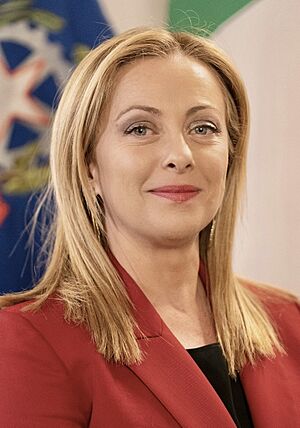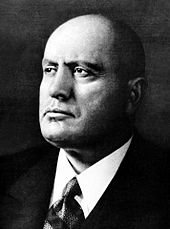Prime Minister of Italy facts for kids
Quick facts for kids President of the Council of Ministers of the Italian Republic |
|
|---|---|

Flag of the President of the Council of Ministers
|
|

Seal of the presidency of the Council of Ministers
|
|
| Council of Ministers of the Italian Republic Government of Italy |
|
| Style | President (reference and spoken) Premier (reference, informal) Her Excellency (diplomatic) |
| Member of | Council of Ministers High Council of Defence European Council |
| Residence | Chigi Palace |
| Seat | Rome |
| Appointer | President of the Republic |
| Term length | No fixed term length |
| Inaugural holder | Alcide De Gasperi (republic) Camillo Benso di Cavour (original) |
| Formation | 17 March 1861 |
| Deputy | Deputy Prime Minister |
| Salary | €99,000 per annum |
The Prime Minister of Italy, officially called the President of the Council of Ministers (Italian: Presidente del Consiglio dei ministri), is the main leader of the Italian government. This important job is described in articles 92–96 of the Constitution of Italy.
The President of the Republic chooses the Prime Minister. To stay in office, the Prime Minister must have the support of the Parliament. This means Parliament must trust their leadership.
Before Italy became a republic, the job was called "President of the Council of Ministers of the Kingdom of Italy." During the Fascist era (1925-1943), the role changed. It became a powerful, dictatorial position held by Benito Mussolini. He was called "Head of the Government, Prime Minister, Secretary of State."
In 1943, King Victor Emmanuel III removed Mussolini. The position was restored, and Pietro Badoglio became Prime Minister. The original title, "President of the Council," returned in 1944 with Ivanoe Bonomi. Alcide De Gasperi became the first Prime Minister of the Italian Republic in 1946.
The Prime Minister leads the Council of Ministers, which holds executive power. This role is similar to prime ministers in many other parliamentary systems. While other officials might be higher in formal ceremonies, the Prime Minister is the country's main political leader. They are the de facto (in practice) chief executive.
Giorgia Meloni has been Italy's Prime Minister since October 22, 2022. She is the first woman to hold this position.
Contents
What the Prime Minister Does
As the leader of the Council of Ministers, the Prime Minister must have the strong support of the Parliament. This support comes from the majority of members who vote.
The Prime Minister has special powers. They can suggest a list of ministers to the President of the Republic. These ministers will then be appointed to the Cabinet. The Prime Minister also signs all laws that the President of the Republic signs.
Article 95 of the Italian Constitution says the Prime Minister "directs and coordinates the activity of the ministers." How much power they use depends on the strength of individual ministers. It also depends on the political parties they represent.
Often, the Prime Minister's job involves helping different parties in the government work together. They act as a mediator. The Prime Minister cannot easily fire ministers. Sometimes, a Prime Minister might resign to form a new government with different ministers. This requires the President's support.
A Look at History
The job of Prime Minister first started in 1848. This was in the Kingdom of Sardinia, which came before modern Italy. The country's constitution at the time did not specifically mention this role.
Early Leaders of Italy
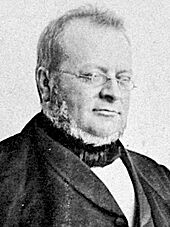
After Italy became a united kingdom, the process stayed similar. The king appointed the Prime Minister. The first Prime Minister was Camillo Benso di Cavour, appointed on March 23, 1861. He passed away just a few months later.
From 1861 to 1911, different groups called the "Historical Right" and "Historical Left" took turns leading the country. At first, the Prime Minister was mainly responsible to the king. Over time, it became clear that the Prime Minister also needed Parliament's trust.
One very important Prime Minister from this time was Francesco Crispi. He was a strong leader from Southern Italy. Crispi led the country for six years, from 1887 to 1891 and again from 1893 to 1896. He was known internationally.
Crispi started as a liberal patriot. However, he became a more authoritarian leader, similar to Otto von Bismarck. His career ended after a banking scandal and a military defeat in Ethiopia in 1896. Some see him as an early example of a leader like Benito Mussolini.
The Giolittian Era
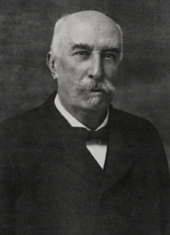
In 1892, Giovanni Giolitti became Prime Minister. He was a lawyer and politician. After less than a year, he had to resign. He returned to power in 1903. Giolitti served as Prime Minister five times between 1892 and 1921. He is the second-longest serving Prime Minister in Italian history.
Giolitti was skilled at creating flexible political groups in Parliament. He tried to keep extreme political ideas from both the left and right out of power. Under his influence, Italian Liberals did not form a strong, organized party.
The time between the early 1900s and the start of World War I is often called the Giolittian Era. During this period, Giolitti was Prime Minister for most of the time. He brought in many new social reforms. These changes helped improve the lives of ordinary Italians.
Giolitti's government also took control of private telephone and railroad companies. He believed that a strong national economy was very important.
The Fascist Regime
Italy's government was very unstable in its early years. Between 1861 and 1921, the country changed its leader 37 times.
When Benito Mussolini became Prime Minister in 1922, his first goal was to stop Parliament from being able to remove him. He wanted his power to come only from the King and his National Fascist Party. Mussolini used his secret police to crush all political opposition. He also made labor strikes illegal.
Mussolini and his Fascist followers passed laws that turned Italy into a one-party dictatorship. Within five years, he had total control. In 1925, his title changed to "Head of the Government, Prime Minister Secretary of State." This showed his new dictatorial powers. He even passed a law saying he was not responsible to Parliament.
Mussolini stayed in power until 1943. King Victor Emmanuel III removed him after a vote by the Grand Council of Fascism. General Pietro Badoglio replaced him. A few months later, Nazi Germany invaded Italy. Mussolini was put back in charge of a puppet state called the Italian Social Republic. The King's government moved to Southern Italy, which was controlled by the Allied Forces.
In 1944, Badoglio resigned. Ivanoe Bonomi became Prime Minister, bringing back the old title "President of the Council of Ministers." After Bonomi, Ferruccio Parri briefly served in 1945. Then, Alcide De Gasperi, leader of the new Christian Democracy party, took over.
The Italian Republic's First Decades
In 1946, Italy voted to abolish the monarchy. De Gasperi became the first Prime Minister of the new Italian Republic. For many years, the Christian Democracy party was the main party in government. The Italian Communist Party (PCI) was the largest opposition party.
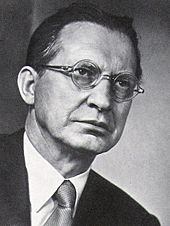
De Gasperi led the government for several years. He is also seen as one of the founding fathers of the European Union.
After De Gasperi's death, Italy had a period of political instability. Many governments were formed in a short time. Later in the 20th century, Giulio Andreotti, a protégé of De Gasperi, became Prime Minister seven times between 1972 and 1992.
From the late 1960s to the early 1980s, Italy went through a difficult time called the Years of Lead. There was an economic crisis, social conflicts, and terrorist attacks. The assassination of Christian Democrat leader Aldo Moro in 1978 was a major event.
In the 1980s, for the first time since 1945, two governments were led by non-Christian Democrat prime ministers: Giovanni Spadolini (Republican) and Bettino Craxi (Socialist). However, the Christian Democrats remained the main party in power. During Craxi's time, Italy's economy improved. But government spending also caused the national debt to grow very large.
In the early 1990s, Italy faced big problems. Voters were tired of political issues, huge public debt, and widespread corruption. An investigation called "Clean Hands" uncovered a lot of corruption. This led to major changes in Italian politics. The Christian Democrats, who had ruled for almost 50 years, broke apart. The Communist Party also changed into a social-democratic party.
The "Second Republic"
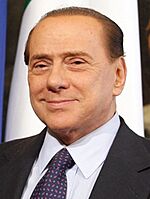
In 1994, during the "Clean Hands" investigation, media owner Silvio Berlusconi started the Forza Italia (Forward Italy) party. He won the elections and became a very important political figure for the next decade. Berlusconi is the longest-serving Prime Minister in the history of the Italian Republic.
After a short first term, Berlusconi returned to power in 2001. He lost the 2006 election to Romano Prodi. But he won again in 2008, becoming Prime Minister for the third time. In November 2011, Berlusconi resigned. Mario Monti then formed a new government. This government was made up of experts and supported by both center-left and center-right parties.
In April 2013, Enrico Letta led a new government. This government also included both center-left and center-right parties. On February 22, 2014, Matteo Renzi became the new Prime Minister. Renzi suggested many reforms, including changes to the Senate. However, these reforms were rejected in a vote in December 2016. Renzi then resigned. His Foreign Affairs Minister, Paolo Gentiloni, became the new Prime Minister.
On June 1, 2018, Giuseppe Conte became Prime Minister. He led a government of the Five Star Movement and the League. After the 2019 European Parliament election, the League became stronger than the Five Star Movement. Matteo Salvini (leader of the League) tried to remove Conte. Conte resigned. But after discussions, Conte was reappointed as Prime Minister. He then led a government with the Five Star Movement and the Democratic Party.
In January 2021, a centrist party led by former Prime Minister Renzi stopped supporting Conte's government. In February 2021, President Sergio Mattarella appointed Mario Draghi as Prime Minister. Draghi was the former President of the European Central Bank. His new government was supported by most Italian parties.
In October 2022, President Mattarella appointed Giorgia Meloni as Italy's first female Prime Minister. This happened after Mario Draghi resigned and a general election was held.
See also
 In Spanish: Presidente del Consejo de Ministros de Italia para niños
In Spanish: Presidente del Consejo de Ministros de Italia para niños
- List of prime ministers of Italy
- List of international trips made by prime ministers of Italy
- Deputy Prime Minister of Italy
External links
- Website of the Prime Minister of Italy
- List of Italian Prime Ministers, with information on length of term and party membership
la:Praeses consilii ministrorum


